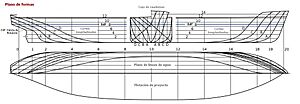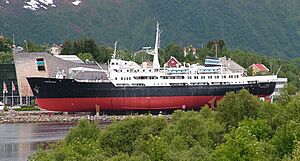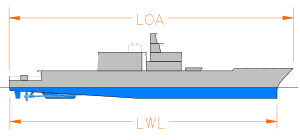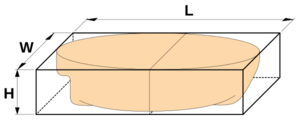Hull (watercraft) facts for kids
A hull is the main body of a ship, boat, submarine, or even a flying boat. Think of it as the part that floats in the water. It's built to be watertight, meaning no water can get inside. Sometimes, the top of the hull is open, like on a small dinghy. Other times, it's covered by a deck, which is like a floor. On top of the deck, you might see a deckhouse (a small building) or other parts like a funnel, crane, or mast. The line where the hull touches the water is called the waterline.
Contents
Exploring Hull Designs
Ships and boats come in many shapes and sizes, and so do their hulls! The way a hull is shaped depends on what the vessel needs to do. For example, a simple barge might have a boxy hull to carry lots of cargo. A fast racing sailboat, however, will have a very sleek, sharp hull to cut through the water quickly.
Designers choose a hull shape by balancing many things. They think about how much it will cost to build, how much it can carry, and how stable it will be. They also consider how fast it needs to go and how it will handle waves. Special jobs also influence the shape, like the strong, rounded front of an icebreaker or the flat bottom of a landing craft that needs to go onto a beach.
Modern ships, often made of steel, have hulls built with strong parts. Inside, you'll find watertight decks and big walls called bulkheads. These bulkheads divide the ship into different sections and help keep it afloat if one part gets damaged. There are also other strong pieces like beams and frames that give the hull its shape and strength. The very top deck that runs along the whole ship might have different names, like the "upper deck" or "main deck". The name often depends on the type of ship.
Older boats, especially sailboats, were often made of wood. Their hulls were built from wooden planks supported by curved frames, much like ribs in a body. These parts were held together by long pieces of wood. Many boats also have a strong beam running along the bottom called a keel. Today, many boats are made from fiberglass or other strong, lightweight materials. These hulls can be built by layering thin, strong sheets over a light core, like foam. This makes them very strong but not too heavy.
People have been building hulls for a very long time! The Ancient Egyptians were among the first to build proper hulls. Around 3000 BC, they already knew how to put wooden planks together to create a strong boat body.
Different Hull Shapes
Hulls come in many different shapes, but we can group them into two main types:
- Chined hulls: These hulls have sharp angles or "knuckles" where the bottom meets the sides. Think of a folded piece of paper. Examples include flat-bottom boats or V-shaped hulls.
- Smooth curve hulls: These hulls have gentle, rounded curves, like a smooth bowl. They don't have sharp angles. Examples include round-bottom boats.
How Hulls Move Through Water
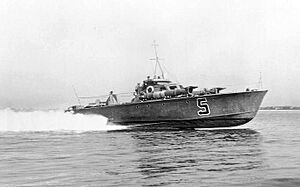
Hulls also behave differently in the water, especially when it comes to speed:
- Displacement hulls: These hulls always push water out of the way as they move. They are supported mainly by buoyancy, which is the upward push of the water. Most large ships and slow boats are displacement hulls. They have a natural speed limit based on their length.
- Planing hulls: These hulls are designed to lift partly out of the water as they go faster. They create their own "lift" from the water pressure, like an airplane wing. This reduces the part of the hull touching the water, making them much faster. Planing hulls often have flat or V-shaped bottoms and are common on speedboats. They need powerful engines to get up to speed.
- Semi-displacement hulls: These hulls are a mix of both. They can get some lift from speed but still rely mostly on buoyancy. They are faster than pure displacement hulls but don't lift as much as planing hulls.
Common Hull Shapes Explained
The round bilge hull is a very common type today. It has smooth, curved sides. When a boat with this hull carries a light load, less of it sits in the water. This means less drag and more speed. When it carries a heavier load, it sits deeper, but its curved shape helps it move smoothly through waves.
Hulls with Angles: Chined Designs
A chined hull doesn't have smooth, rounded sides. Instead, it has sharp angles, or "chines," where the bottom and sides meet. The sharper the angle, the "harder" the chine. Some hulls can even have more than one chine on each side.
One example of a boat with hard chines is the Cajun "pirogue."
These hulls can be cheaper to build. They often have a flatter bottom, which helps boats go faster when planing. In calm water, a hard chined hull resists rolling more than a rounded hull. However, in rough seas, they can sometimes feel less smooth because the sharp angles can cause more bumping.
Chined hulls come in a few main shapes:
- Flat-bottom chined hulls: These are very stable when still, but can have more drag when moving. They are best for calm waters.
- Multi-chined hulls: These have several gentle angles, making them closer to a curved shape. They are more complex to build but can handle rougher seas better.
- V-bottom chined hulls: These have a V-shape at the bottom. A flatter V-shape (around 6 degrees) helps a boat plane easily. A deeper V-shape (around 18 to 23 degrees) needs more power but gives a faster, smoother ride in waves. This V-angle is sometimes called the deadrise.
Hulls with Curves: Smooth Designs
Smooth curve hulls have rounded shapes. They often use a centreboard (a retractable fin) or a fixed keel to help with stability and steering.
Semi-round bilge hulls are not as fully rounded as some. They offer a good balance between the very rounded "S-bottom" hulls and the angled "chined" hulls. You can see semi-round bilge hulls on popular sailing dinghies like the Centaur and Laser.
S-bottom hulls are a type of smooth curve hull, often found on older sailboats. If you look at a cross-section of the hull, it looks like the letter "S." The sides curve smoothly into the keel at the bottom, without any sharp angles. These boats might have a long, fixed keel or a shorter one with a centreboard inside. This hull shape was very popular from the late 1800s to the mid-1900s. Small sailboats like the Yngling and Randmeer use this S-shape.
Extra Parts of a Hull
Hulls often have extra parts attached to them to help them move or stay stable:
- Control devices: These help steer the boat, like a rudder at the back. Some boats also have trim tabs or fins to help with balance.
- Keel: A keel is a long fin on the bottom of the hull. It helps keep the boat stable and moving straight. It can also help sailboats "lift" against the wind.
- Retractable parts: Some boats have fins that can be pulled up or lowered, like centreboards and daggerboards. This is useful in shallow water.
- Bulbous bow: This is a large, rounded bulge at the front of some big ships, below the waterline. It helps the ship move through the water more easily, reducing drag and saving fuel.
Important Hull Terms
Here are some important words you'll hear when talking about hulls:
- Bow: This is the very front part of the hull.
- Stern: This is the very back part of the hull.
- Port: This is the left side of the boat when you are looking towards the bow.
- Starboard: This is the right side of the boat when you are looking towards the bow.
- Waterline: This is the line around the hull where the water surface touches it when the boat is floating still.
- Amidships: This refers to the middle part of the boat, from front to back.
- Baseline: This is a flat reference line used to measure vertical distances on the hull.
Measuring a Hull
To understand and compare different hulls, naval architects (ship designers) use special measurements.
Key Hull Dimensions
These are the main sizes of a hull:
- Length Overall (LOA): This is the total length of the boat from its very front to its very back.
- Length at the Waterline (LWL): This is the length of the hull where it touches the water.
- Beam (B): This is the widest part of the hull.
- Draft (d or T): This is how deep the hull goes into the water, measured from the bottom of the keel to the waterline.
- Freeboard (FB): This is the height of the hull from the waterline up to the main deck. It shows how much of the hull is above the water.
- Moulded Depth (D): This is the vertical distance measured from the top of the hull to the underside of the upper deck.
Understanding Hull Fullness
Designers also use measurements to describe how "full" or "sleek" a hull is:
- Displacement (Δ): This is the weight of the water that the hull pushes aside when it floats. This weight is equal to the total weight of the ship itself.
- Volume (V): This is the actual amount of water the hull displaces.
- Block Coefficient (Cb): Imagine drawing a perfect rectangular box around the underwater part of the hull. The block coefficient tells you how much of that box the hull actually fills. A high Cb means a very full, boxy hull (like a tanker). A low Cb means a sleek, slender hull (like a sailboat).
- Prismatic Coefficient (Cp): This helps describe how the hull's volume is spread out along its length. A high Cp means the hull is full at both ends, while a low Cp means it's fuller in the middle and tapers at the ends.
Designing Hulls with Computers
In the past, ship designers drew hulls by hand and did all the math themselves. But today, they use computers! Since the early 1990s, special software has been developed for designing ships. These programs let designers create 3D models of hulls. They can also calculate how the hull will float and move through the water. This makes designing ships much faster and more accurate.
See also
 In Spanish: Casco (náutica) para niños
In Spanish: Casco (náutica) para niños
- Anti-fouling paint
- Boat
- Cathedral hull
- Chainplate
- Copper sheathing
- Displacement–length ratio
- Double hull
- Draft
- Froude number
- Hull classification symbol
- Hull speed
- Lift (force)
- Monohull
- Multihull
- Naval architecture
- Nelson Chequer
- Ship measurements
- Shipbuilding
- Submarine
- Submarine hull


